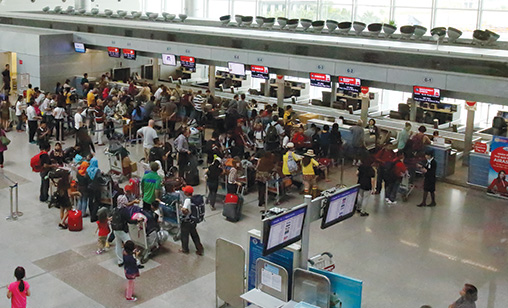News Backgrounder
Traveller checklist for safe flying
September 1st 2020
A new poll of prospective air travelers has shown many of them are prepared to return to the air but only if certain conditions are met. Read More » Conducted in July by Travelport, the survey asked 5,000 travelers from Australia, New Zealand, India, the UK and the U.S. to list the safety measures airlines, airports, hotels and car rental companies must have in place to give them sufficient confidence to book an international or domestic trip.
The survey found 71% of respondents ranked an enhanced cleaning program during and between flights as a “very important” factor that would influence them booking a flight and 69% of those surveyed said making hand sanitizer available at baggage points was “very important”.
 |
Other responses to the survey included:
• 68% said social distancing was a critical measure to have in place at airports.
• 66% said social distancing was “very important” onboard.
• 66% of respondents said temperature checks are “very important”, both at the airport entrance and before boarding.
• 64% said fully flexible/refundable tickets were a “very important” consideration when choosing to travel.
Overall, travelers wanted as many safety measures in place as possible, with most of the proposed cleaning and hygiene measures seen as essential to restoring confidence.
“Our research shows encouraging signs there is a willingness to fly as long as these measures are in place at key points along the customer journey,” Travelport said.
In general, the safety and hygiene measures suppliers were implementing matched travelers’ expectations about safe travelling. Documenting and effectively communicating these measures for travelers was critical to enable travel agencies to guide and advise bookers, Travelport said in a survey statement.
More than half of travelers would consider booking a flight if they knew in advance stringent safety measures had been implemented by the airline and airport.
Separately, the International Air Transport Association (IATA) has appealed to all travelers to wear face coverings during the travel journey for the safety of all passengers and crew during COVID-19. Wearing a face covering is a key recommendation of the International Civil Aviation Organisation’s (ICAO) guidance for safe operations during the pandemic, developed jointly with the World Health Organization and governments.
IATA is emphasizing the need for passengers to comply with the recommendations following recent reports of travelers refusing to wear a face covering during a flight. While confined to a very small number of individuals, some on board incidents have become violent and resulted in costly and extremely inconvenient diversions to offload these passengers.
“This is a call for common sense and taking responsibility. The vast majority of travellers understand the importance of face covering both for them and for their fellow passengers and airlines appreciate this collective effort,” an IATA statement said.
“But a small minority creates problems. Safety is at the core of aviation, and compliance with crew safety instructions is the law. Failure to comply can jeopardize a flight’s safety, disrupt the travel experience of other passengers and impact the work environment for crew,” said IATA director general and CEO, Alexandre de Juniac.
According to tests at the University of Edinburgh, properly worn face coverings can cut the forward spread of potential COVID-19 droplets from the mouth by 90%. Other measures to protect the safety of passengers during the pandemic include contactless check-in and immigration formalities at both departure and arrival airports, social distancing where possible, increased cleaning and sanitization at airports and on aircraft and contact tracing.
“The research we have seen to date, and our own investigations with the world’s airlines, tell us the risk of catching COVID-19 on a flight remains very low. There appears to be a number of factors that all play a part. They are a high flow rate of cabin air from top to bottom, constant filtering of air through state-of-the-art HEPA filters, the fact all seats face the same direction, wearing a face covering and sanitization of the aircraft .” said IATA’s medical advisor, Dr David Powell.